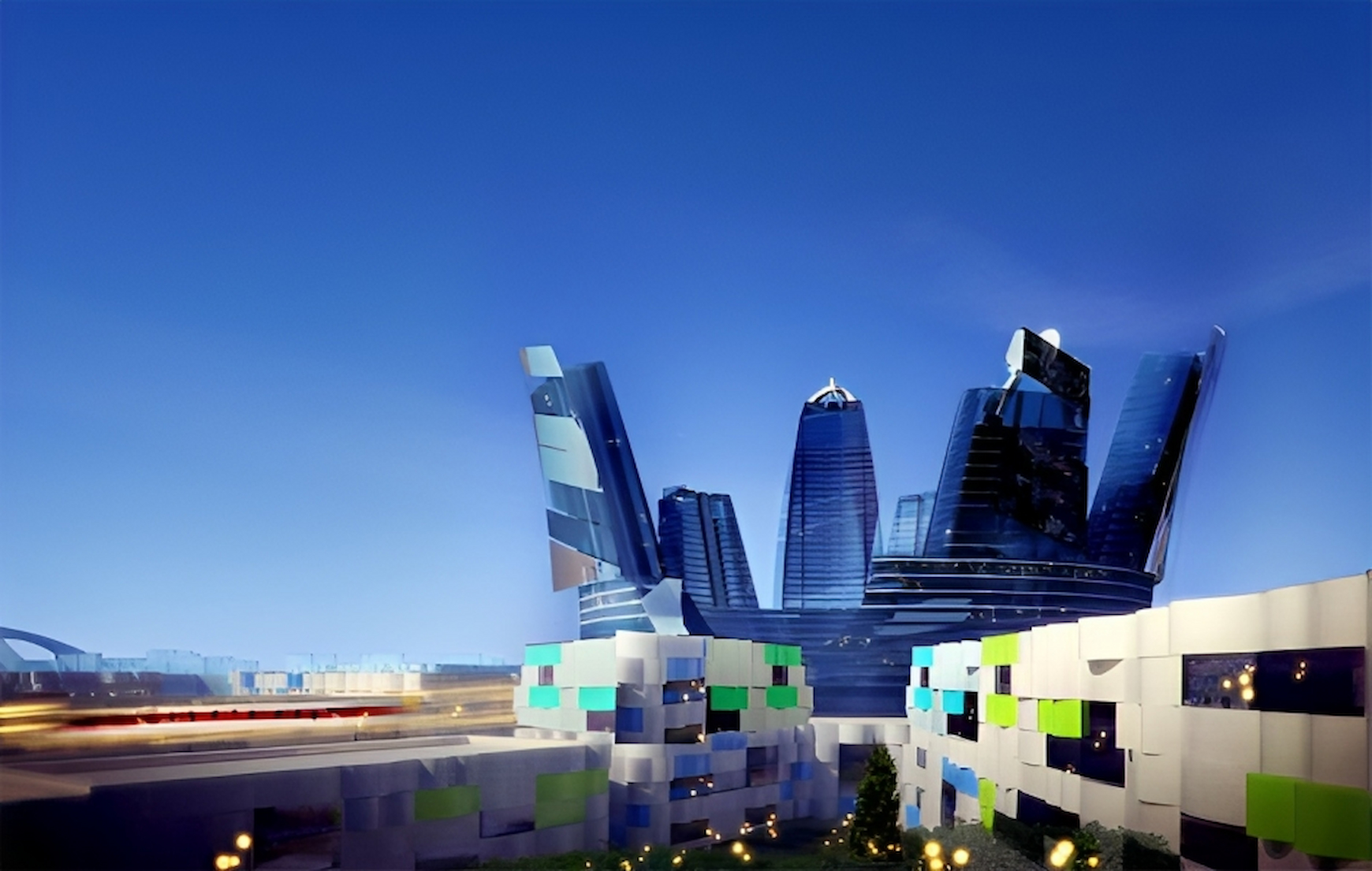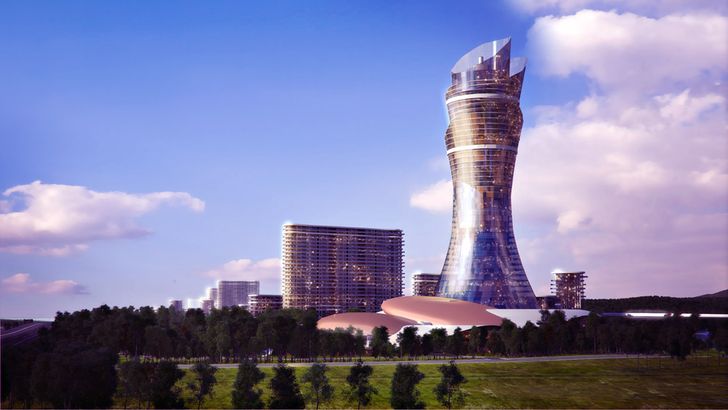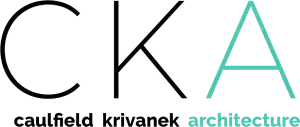
Since stepping down as CEO of Archicentre, Robert Caulfield has secured several spectacular international design commissions for his architectural company, CK Designworks. He explains how Australian architects can be successful overseas, particularly in China.
Nanjing civic centre (Image: CK Designworks)
One of the most enlightening things that I have learned from undertaking overseas commissions is that Australian architects are as good as any in the world and probably better than most.
Having that knowledge – and confidence in our own skills – means that we can all have the opportunity of securing commissions which are more exciting than we could even dream of in Australia. And if we manage them well we can develop a cash flow stream that insulates us from the inconsistencies of the Australian building industry.
CK Designworks made a conscious decision in 2007 to strive for overseas commissions. The reasons were twofold – we wanted to secure an alternative cash flow but, more importantly, after 30 years of practice we wanted to have fun.
It was far easier than we thought. Initially we aimed at Dubai. We booked a stand at the annual Dubai Cityscape exhibition, one of the largest building exhibitions in the world (wasn’t everything that way in Dubai?).
Pearl Dubai. This project was designed in collaboration with Schweger Associates, Hamburg, Germany. (Image: CK Designworks)
Dzerzhinsky Avenue, Minsk, Belarus. (Image: CK Designworks)
My partner Ivo Krivanek and I made a conscious effort to meet and greet. Armed with brochures showing off some of our Australian projects, we soon made contacts, but the key was an optimistic sales pitch about how we could help local developers achieve the sorts of miracles they had come to expect. It was mostly bluff and bluster on our part, but it worked. We soon had design commissions in Tehran, Minsk, Abu Dhabi and Baku, as well as Dubai. Most were concepts but two of them, the Dubai Pearl and Dzerzhinsky Avenue, Minsk, went through to construction. It was obvious early on that, to succeed, we needed an office there, but we were hesitant about gearing up as a large office. So we made the decision to locate one of our partners, Janusz Kowal, in a serviced office in Dubai, do all of the work in Melbourne and electronically transfer drawings to Dubai.
This in hindsight was a wise move because, when Dubai crashed in early 2009, we weren’t saddled with huge overheads as many other architectural practices were.
Our golden rule was that we would not start on any project unless we were paid a mobilization fee of 10% to 20% of our total fee up front. This quickly established whether or not new clients were real or just real estate sharks looking for free schemes to help sell land. Sounds familiar doesn’t it.
We are still owed money but, overall, we are financially well ahead. The Dubai economy was almost totally fuelled by property speculation – the classic magic pudding.
When my time was freed up from Archicentre in November 2009, we developed a strategy to tap into the Asian market, particularly Vietnam and China.
We soon learned that poorer countries such as Burma, Cambodia and Vietnam had plenty of grand aspirations but no money to pay for them. Speculative concepts requested by developers went nowhere, although the mobilization fees sorted out most of the tyre kickers who were after free concepts to help with land sales.
China was a totally different situation. Cities like Shanghai, Nanjing and Beijing are relatively wealthy and the government is pushing development at a phenomenal rate. Unlike Dubai, the demand is real, with about 400 million people still to be re-housed in new accommodation and all of the infrastructure that goes with it.
There is so much exciting work in China that Aussie architects should give it a go. The more of us who plant our flag there, the more respect we will all achieve.
We have found that in a relatively short time we have been able to establish an international reputation and have prospective clients come to us.
Here is how we did it.
Whenever a presentation is made to a prospective client, they will check your website and Google search the partners almost before you have left the room. We revamped our website, keeping in mind that Chinese censorship slows down transmission rates, meaning that animations or rolling images just don’t work.
To lift Google ratings we established an international architectural press release system comprising forty or so electronic and paper magazines and prepared about two media releases per month. We have a unique advantage here from the experience of establishing Archicentre’s spectacularly successful Australian press release and media system.
Within six months we had scores of project reviews in about twenty different countries. A medium sized Camberwell architectural practice was now on the international stage.
We selected a number of complementary companies to work with who had connections in both Melbourne and China – a research company, a development consultant and several developers. Between us, we sourced prospective projects, prepared presentations and secured projects.

Nanjing research and development centre. (Image: CK Designworks)

The Splash Building – Nanjing commercial and retail hub. (Image: CK Designworks)
Perhaps one of the most gratifying results is that our two largest government projects, the first, a 20 square kilometre hi-tech industrial centre housing 200,000 people and providing 1.6 million jobs, and the second, a 40 square kilometre master plan of Nanjing’s heritage area, were won against competing companies from Singapore, Taiwan, the UK and China, proving that Australian architects are indeed as good as any. We now have five significant projects in China and have presentations for several more. They have given our staff the opportunity of working on prestige projects they would never have dreamed possible, as well as giving the practice an international image and a diverse source of income. I would recommend that you go for it too.
Working in China – a checklist
- Your website and Google ratings are imperative in establishing an international image. Snappy animation and rolling images don’t work through China’s censored internet filters. A Wikipedia entry is worthwhile too. Use the Google translation rather than preparing specific Chinese pages.
- Make as many contacts as you can and keep in contact with them. “Guanxi”, the Chinese version of a network, includes friends and family. It is your most important source of ongoing work.
- Don’t accept a commission unless you secure a mobilization fee. An amount of 15% to 30% up front is common.
- You will be expected to sign and “chop” a contract. Chops are company stamps and are more important than signatures, but, beware, a contract in China is similar to our Memorandum of Understanding. After it is signed you will be asked to expand your scope of work and reduce your fee.
- Prepare a time schedule for your work and a schedule of payments with agreed dates. Australian architectural practices working in China all have stories about not being paid. As soon as payments fall behind – stop work, otherwise you will be seen as a soft touch.
- The Chinese education system is all about learning and repetition. Chinese architects may develop an interesting design concept but will destroy it by repeating it over and over, such as with the repetitive construction of apartments. However, many clients will have international exposure and are looking for exciting international design styles. They prefer international architects to local ones.
- You will be expected to celebrate the project by toasting with “Bei Jo” a dreadful tasting white spirit at lunch and dinner. It is universal and an important part of building your “guanxi” or network.
- At lunch or dinner you may be asked all sorts of personal questions such as your age, possibly even your weight and height. Increasing age means increasing respect, up to about 70. You may be told you are skinny or fat, but don’t be offended, it is not intended that way. Sometimes being overweight signifies success.
Build your international image
CK Designworks can help other Australian architectural companies build their international image through CK Designworks’ growing list of international electronic magazines contacts. To qualify for distribution, the partners of your practice must be Australian Institute of Architects members, your project must have international significance, and you need to submit an accompanying professionally written article of about 500 words and first class photographs or images. Contact Robert Caulfield at Robert@ckdesignworks.com.
Originally published 09 August 2011 in ArchitectureAU



